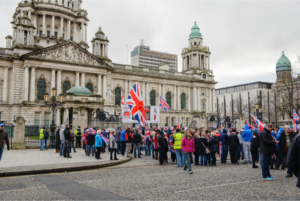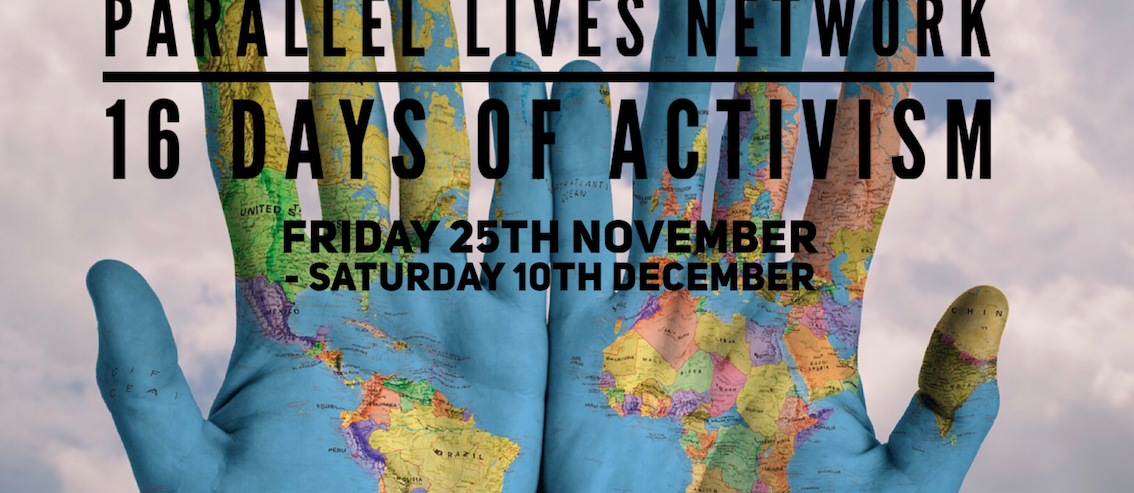Day 4 #16DaysOfActivism
Welcome to Day 4 of #16DaysOfActivism from across the Parallel Lives Network.
As this week marks 10 years since the ‘flag protests’ of his research, it’s a good time to catch up with Dr Paul Reilly about his book published on 19th January 2021 titled, ‘Digital contention in a divided society‘ – Social media, parades and protests in Northern Ireland.
We discussed how platforms such as Facebook and Twitter are used by citizens to frame contentious parades and protests in ‘post-conflict’ Northern Ireland. What do these contentious episodes tell us about the potential of information and communication technologies to promote positive intergroup contact in a deeply divided society?
These issues are addressed in what is the first in-depth qualitative exploration of how social media were used during the union flag protests (December 2012-March 2013) and the Ardoyne parade disputes (July 2014 and 2015).
Paul has also contributed a blog post following our conversation that is reproduced in full below:
Social media highlights divisions and the need for political leadership in Northern Ireland
This week marks ten years since the union flag protests in Northern Ireland. Like many others, my own memories of the protests and related violence were shaped by the tweets, videos and images that circulated online. These were also the first demonstrations of their kind to be contested on platforms such as Facebook, Twitter and YouTube.
In my book, I argued that this was a watershed moment in contentious politics within the post-conflict society. While these were shared spaces where critics and supporters could express their views on the protests, online exchanges reinforced divisions between loyalist flag protesters and their critics. The negative stereotyping of loyalists as inbred bigots, concerted efforts to inflame tensions through the sharing of disinformation, and the presence of sectarian hate speech contradicted the claims by online platforms that they were a force for global peace.

A decade later, one might be forgiven for feeling a sense of déjà vu. Anti-Protocol demonstrations feature many of the same protagonists from the flag protests, again expressing grievances about what they perceive as an attack on their identity. Activists like Jamie Bryson are once more using online platforms to articulate their opposition to the ‘Irish Sea Border’, and also the Belfast/Good Friday Agreement itself. This has inevitably led to much trolling and abuse being directed towards those behind these demonstrations. Meanwhile, Twitter hashtags such as #brexitriots are used to both dehumanise loyalists and to score political points about the negative consequences of the UK’s decision to leave the European Union.
The most recent Twitter storm has revolved around a video selfie in which a young woman filmed herself with former DUP leader Arlene Foster singing “ooh ah, up the RA”. The subsequent social media pile-on saw many calls for her to be dismissed from her job, with victims groups calling on the woman to apologise for “mainstreaming” IRA violence. A picture in which she was seen holding an AK-47 rifle circulated online and was reproduced in the Sunday Life. This was not the first time that a social media ‘joke’ had caused such controversy. In 2018 Sinn Fein representative Barry McElduff received death threats for a video in which he appeared to mock the anniversary of the 1976 Kingsmill massacre. These incidents show how sites like Twitter provide rich pickings for professional journalists looking for a story.
I have argued previously that social media shouldn’t be held responsible for the sectarianism and sporadic violence that persists in post-conflict Northern Ireland. While it is undeniable that platforms like WhatsApp have made it easier to organise protests (and riots), people still need to be motivated to act on information received via these channels. To paraphrase a colleague, blaming protests and related violence on social media is akin to crediting the fax machine with bringing down the Berlin Wall in 1989.
The reality is that we often overstate the prevalence of online harms and the influence of online platforms on real world events. Belfast Telegraph journalist Alison Morris recently argued that social media makes it appear as if sectarianism “is far more widespread than it is”, suggesting that much of the social media hate she experienced was generated by a small group of people operating multiple accounts. People also appear more circumspect in their use of online platforms, and are not as susceptible to false or incendiary content as previously thought. Recent research indicates that only one in four Northern Irish adults use Facebook and YouTube to follow news, and only one in five trust online platforms as an information source. Moreover, it is highly unlikely that citizens would first learn about contentious issues via their social media accounts. Whether directly or indirectly, people growing up in a divided society are quickly made aware of conflict legacy issues and the persistence of sectarian divisions.
Social media undoubtedly amplify sectarian and divisive rhetoric that pollutes public discourse and makes it harder to promote reconciliation in post-conflict societies. However, it would be misleading to suggest that greater platform regulation alone will solve these issues. After all, people typically become aware of social media controversies like the “Up the Ra” video via television and print media rather than via these platforms. Hence, advocates of peace journalism suggest that news media have a responsibility to provide more in-depth analysis of contentious issues rather than concentrate on the Twitter storms such as those discussed above. Too often we focus on how issues are represented in the media rather than those who have the power to deal with them. The persistence of sectarian attitudes is due to the failure of political leaders to address the issues of conflict legacy rather than the moderation policies of big tech companies. It’s time for them to change the conversation, both on and offline.
Dr Paul Reilly
I’ve been lucky to host several conversation’s with Paul over the years including our Sousveillance Newsroom in 2020 at the Documentary Media Centre – click here


Comments
1 Comment
[…] like the latest #16DaysOfActivism – you can watch our together interview on Day 4 – click here to view the blog […]
Leave a Comment